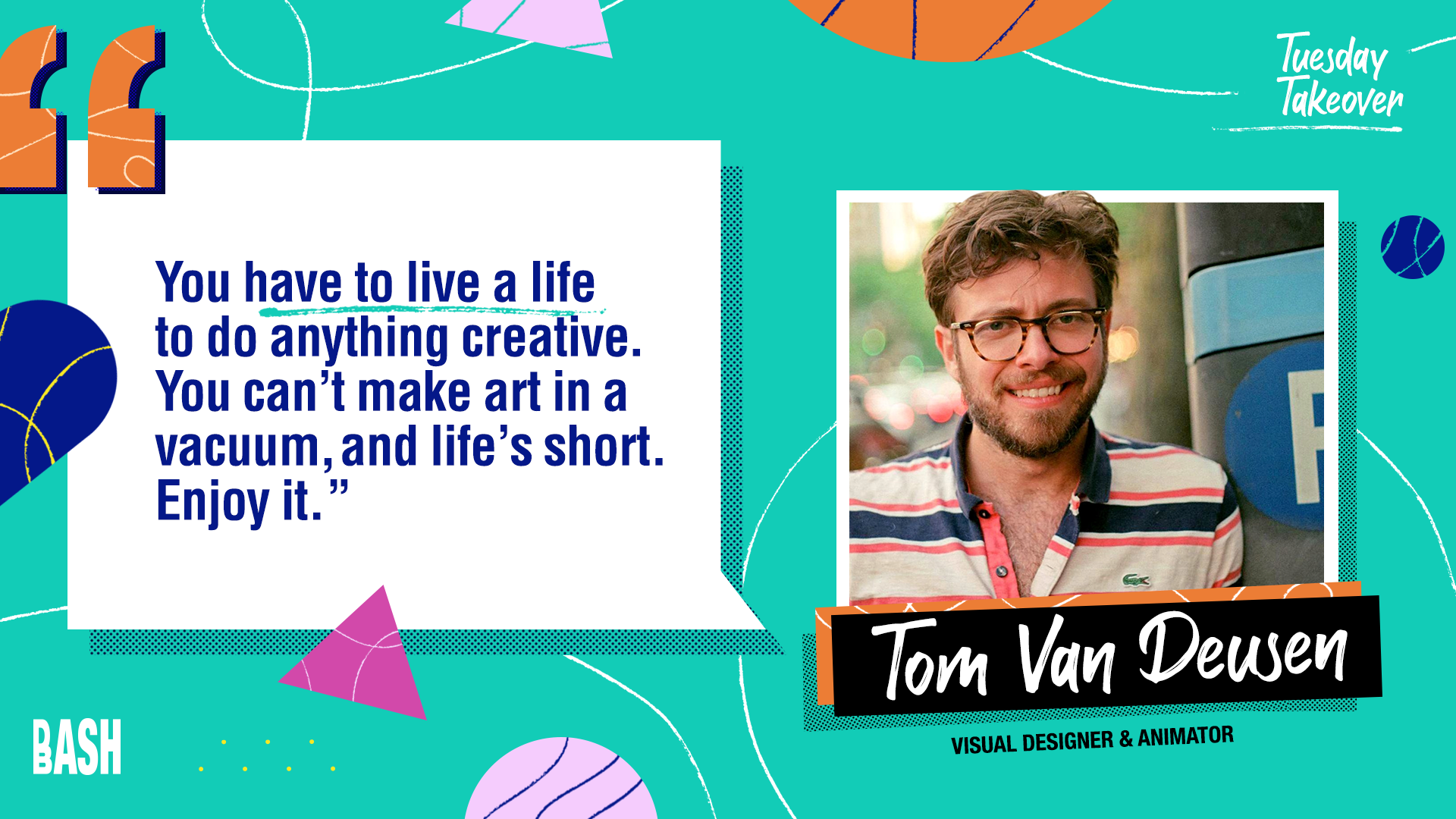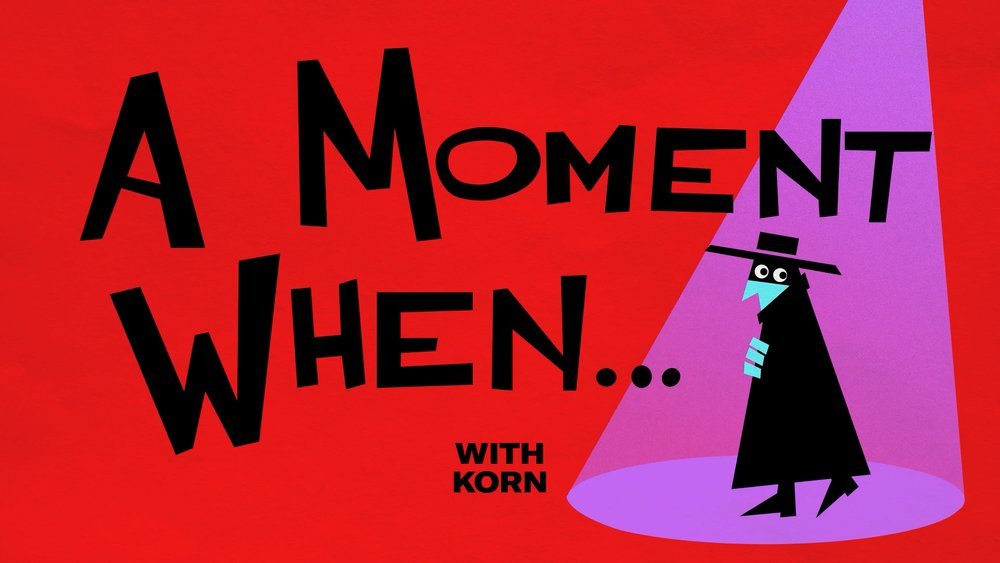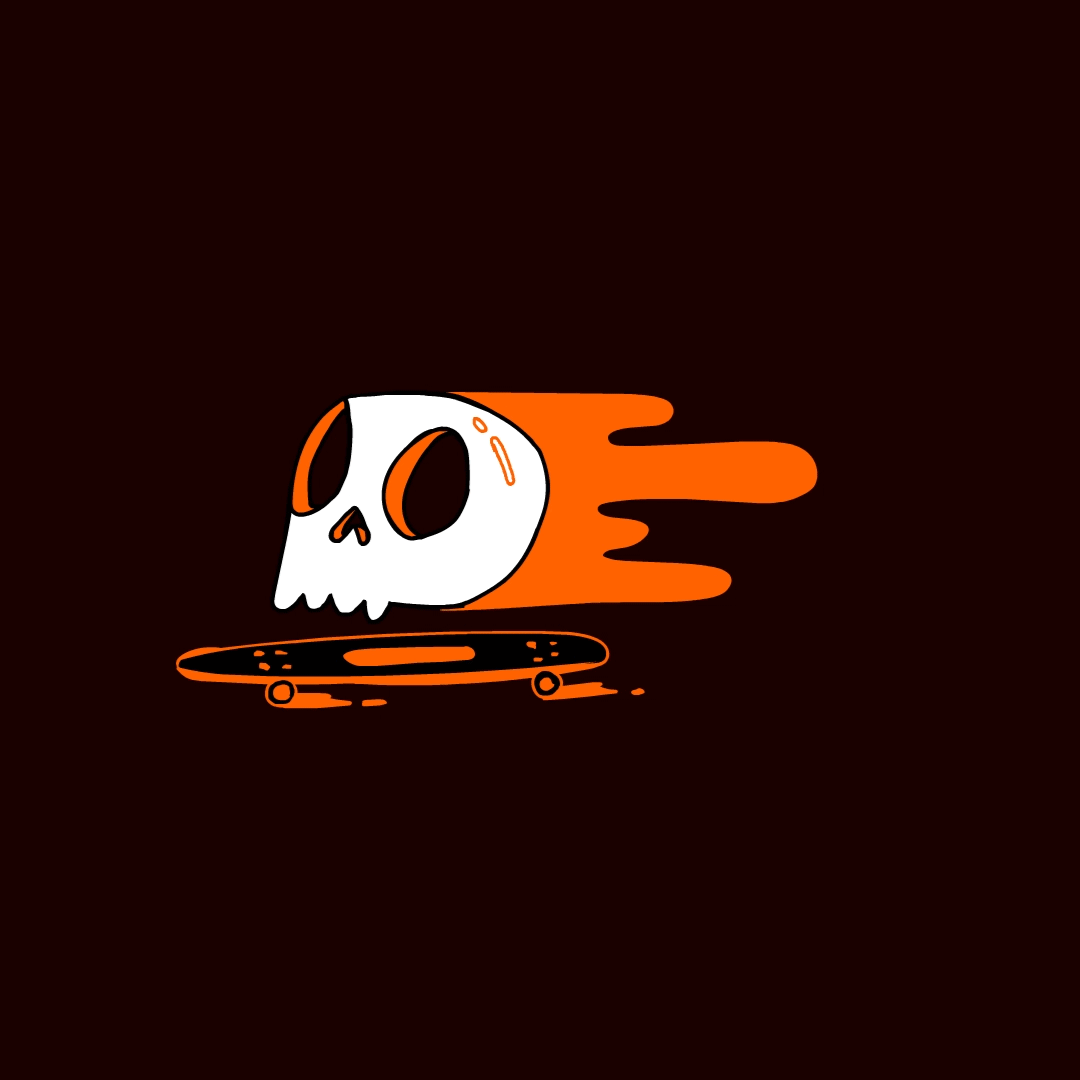Takeover Tuesday with Tom Van Deusen
An interview with Tom Van Deusen an animator and visual designer living in New York City.
Interviewer: Matea Losenegger
Read time: 5min
Matea:
Hey Tom! Thanks for lending your time. Can you please tell us a little about yourself?
Tom:
Thank you! I'm a visual designer and animator based out of New York City. I like to write and draw comics too. I have a cat named Spooky. I'm currently a Senior Motion Designer at a large media company. My favorite color is #CD9704..
Matea:
What is your background and how did you wind up in the motion design world?
Tom:
I grew up loving to write and draw, glued to the television during the golden age of deranged, socially irresponsible cartoons of the mid-90s. My mom was an art teacher and was fully encouraging of all my creative pursuits. I'll never forgive her. I earned a BFA in 2008 and entered the workforce fabulously ill-suited for a global recession.
Over the subsequent 11 years I worked a lot of interesting jobs, from Network Control Center Technician to Financial Operations Analyst. Very interesting. At night I did freelance illustration and wrote hundreds of pages of comics. I have some books that got published that are really screwing up my SEO.
Anyhoo, at the age of 33 I went back to school for graphic design at the advice of several designer friends who sensed how thoroughly miserable I was. There's a great program they had attended called the Seattle Creative Academy. I learned visual design, UX/UI, packaging and a bit of motion.
I had enough motion footage by graduation to put together a reel. I applied to oodles of jobs and got an offer for a visual design job and a motion design job the same week. It was then that I made the difficult decision to take the one that paid a lot better.
Matea:
Do you still use traditional mediums, and do you think it's important for digital artists to flex those more 'tactile' muscles?
Tom:
I was a bit of a luddite in my art-making before going back to school. I drew my comics with a dip pen and Rapidograph. I poo-pooed those who drew on digital tablets, knowing that I was making something physical that will be celebrated by future generations.
Now I'm drawing mostly digitally, and there will be less stuff for my grandchildren to throw into a landfill. I still draw on paper sometimes, but usually just sketches or life drawing. I feel very good about myself when I tap the paper with two fingers to undo before I realize I actually need to use my eraser. My goal is to have my life's work be inaccessible when I stop paying for Creative Cloud.
Matea:
Congratulations on cooking up a spicy new reel! It's a process many of us dread, but yours turned out great. What would you say goes into creating a compelling one?
Tom:
Thank you very much! I've made a lot of stuff over the past years and it was difficult to pare it down and objectively look at it. To make a good reel I'd say takes watching YouTube videos on how to make a good reel. It was also extremely helpful to get feedback from a lot of other, talented motion designers such as yourself. It's hard to tell what's garbage when everything is your precious baby. Sometimes your precious baby is garbage.
Check out Tom’s new reel!
Matea:
It was a really cool idea to incorporate footage of NYC in the opening and close. Has living in the city affected your work at all?
Tom:
Thanks! I moved here from Seattle about a year ago to be closer to family and because my job is in Manhattan. I wanted to incorporate some real-life video footage in addition to my animation, and filmed some stuff on my phone. Because I'm in NYC, those shots are footage of NYC.
As far as influence, I love drawing dense urban areas, and there's a lot of that here. I'd love to find a screen printing co-op in the city to print some of those drawings, so if anyone knows of one in the city please let me know!
Matea:
You have such a playful yet striking illustration style. How would you describe your creative voice and what was the process in developing it?
Tom:
That's very kind. I'm definitely a product of alternative comics. That was the "scene" I was in for a very long time. Over the years I simplified my drawings, replacing fussy cross-hatching with flat colors. I also love children's book illustration. Over the years I've been lucky enough to know a lot of talented artists and illustrators, and I'm sure I'm cribbing some of their styles. Or let's just call it osmosis, for legal reasons.
Matea:
In a similar vein, where do you find inspiration?
Tom:
I hate to say the internet, but nowadays there's such easy access to amazing artwork on the internet that I have to say the internet. I hated saying that. I've also gone to a lot of incredible museums and gallery shows in the city, and it's impossible to not be inspired by those. And usually some crazy idea will pop into my head that's funny to me, and it will make me laugh aloud in public. Not sure how or why that happens, but I wish it would stop.
Matea:
If budget and time weren't constraints, what would be your dream project to work on?
Tom:
I'd love to make an animated short based on the comic that I'm working on. It's currently about a duck and an alligator, but will soon include a snake, a mouse and a giraffe. I have a lot written for it but can barely find the time to draw it into a comic. I'm currently drip-feeding it onto my Instagram. The good news is that it's zero budget and nobody cares how long it takes me.
Matea:
Do you have any wisdom for aspiring creatives and what do you wish you had known when you first started out?
Tom:
You have to live a life to do anything creative. Don't fret if you think everyone else has their nose down at their Cintiq while you're drinking White Claws on the beach. You can't make art in a vacuum, and life's short. Enjoy it.
Matea:
Do you have any upcoming projects you're excited to share with the world?
Tom:
I'm actually very excited by that comic I'm working on, even though my productivity doesn't always match that excitement. I'm having fun drawing it, and since it's a personal project that's the important part.
Takeover Tuesday with Liz Galian
An interview with Liz Galian, a freelance designer and illustrator based in Brooklyn.
Q&A with Liz Galian
Read time: 5min
Madison Caprara:
Hi, Liz! Let’s kick off our chat with an introduction to yourself; who are you, what is it that you do, and how did you find yourself where you are today?
Liz Galian:
Hi Madison! I’m a freelance animator and illustrator based in Brooklyn. These days I find myself doing mostly character design and animation, which is a lot of fun for me. As a kid I really loved drawing portraits, so it’s kind of funny that my career meandered me back to that.
Madison Caprara:
What made you want to pursue animation and design as a career? Was there anything specific you saw or experienced, or was it an interest that gradually grew over time?
Liz Galian:
Initially I really just wanted to be an illustrator! My grandfather was an illustrator for a greeting card company and we had his work hanging all over my home growing up. Because of that, I was really privileged to have artistically supportive parents. They encouraged me to go to art school from a very young age, which is so rare. Then, toward the end of my college career I took an animation class on a whim and completely fell in love with it. From there, the more I learned about the motion graphics industry, the more I felt at home there! It’s such an amazing intersection between illustration, design, and animation — and because of that, I get to do the two things I love most without having to choose.
Madison Caprara:
How would you go about describing your signature style or “look”?
Liz Galian:
I’ve always been drawn to really bright, warm colors. These days the style that comes most naturally to me is 2D, graphic, and whimsical. I think a lot of that has to do with how fast projects move in this industry, and the worry that a design will be difficult to animate if it isn’t as simple as possible. I’ve been told that my animating style has a softer flow to it and is usually mistaken as being mostly cel animated (in reality, it’s usually after effects!).
Madison Caprara:
I see that you recently dropped a new reel. It looks great! Are there any particular do's and don't’s that you feel newer creatives and/or students should know before creating and sending a reel out?
Liz Galian:
Thanks so much! The thing I love about reels is that it gets to be a documentation of a few years of your life and your work, where you get to see how much you’ve grown. Every time I post a new reel, it feels like a little celebration. I would say the biggest piece of advice to someone just starting out, is to use their reel as an opportunity to curate what they’re most proud of and experiment with how you can best showcase it. There aren’t any hard and fast rules for what music to use, what aspect ratio it needs to be in, how fast the cuts are, etc. I would say just keep it under a minute and fifteen seconds, and don’t steal other people’s work (obviously) — but beyond that, make it your own and have fun with it!.
Madison Caprara:
What kinds of projects are you currently working on and which has been your favorite so far?
Liz Galian:
My last big project was my reel, so now I’m taking a breather before I dive back into personal projects. This year I want to put more of an emphasis on the illustration side of my art practice, which I think takes a bit of a back seat to the animation side in my day-to-day life. I’ve been working on a deck of Tarot cards in my free time, so I think that might become the first side project I get serious about finishing!
My favorite project I’ve done so far is actually a smaller one I did with Mailchimp in 2020. I had the space to explore a new workflow I hadn’t used before, where I made draft animations in after effects and then traced over them in photoshop. This let me figure out the beats of each animation really quickly, and then invest most of my time in really playing with the line quality I could get out of the really gorgeous photoshop brushes Mailchimp uses. Usually when I cel animate, I do the entire project in one program and had never really given myself permission to mix AE animation with cel animation. That project showed me that every project calls for a new way of execution, and that there’s really no wrong way to get things done.
Madison Caprara:
We’re coming up on two years of living in this pandemic-ruled world–which is crazy to me. Has your life (and work) changed drastically in that period of time?
Liz Galian:
Definitely, but for the better I think! I was already doing a little bit of remote freelancing before the pandemic, mostly when I was art directing with an all-female studio in South Africa called Batch. At the time I remember wishing that more studios were open to working with people remotely, as a lot of studios and artists I really admired and wanted to work with were on the other side of the US. The new work-from-home norm over the past two years has made it possible for me to make new relationships with amazing people I never would have been able to work with, which I’m so thankful for.
The pandemic also made me take a hard look at how little I prioritized my personal life and my health. I started exercising and spending more time with my friends and family, saying no to jobs that asked for too much, and giving myself more grace when I was tired or burnt out. Its caused a big shift in me as a person. Unexpectedly, I think my work has also gotten better because of it.
Madison Caprara:
What practices did you implement to keep your sanity?
Liz Galian:
I’m really into puzzles, so that’s kept me sane! I try to do a little sudoku or a crossword every day, though those have taken a back seat lately to Wordle. I’m also a big book worm, so not having to travel to work every day gives me time to have my coffee and read a chapter or two before I start work in the morning. My favorite thing I’ve read so far during the pandemic is “Understanding Comics” by Scott McCloud. It weirdly helped me learn a lot about pacing in storytelling and all of the visual ways that you can communicate it. I highly recommend it for anyone who animates (or is into comics!)
Madison Caprara:
In your opinion, for someone aspiring to be an animator, how much knowledge outside of animating is required? Can someone who has more of a fine art background make it, or is a higher technical knowledge needed early on?
Liz Galian:
I’m biased because I went into art school not knowing what Adobe was, how to open photoshop, or how animation worked at all. I think like anything, animation is a skill that comes with years of practice, and if you decide to put the hours in, no matter where you start and what background you come from, you’ll get good at it. Nobody is inherently highly skilled at anything on their first try, so the only barrier anyone can face at a skill they want is whether or not they want it badly enough to keep practicing. The internet has endless resources and the animation community is really welcoming and helpful!
Madison Caprara:
On the flip side, what about those more traditional art skills? For someone who wants to be an animator, how important is it for them to have drawing skills?
Liz Galian:
I think it depends on the kind of animation you want to do. If you’re interested in cel animation, drawing is a skill you might want to invest time in. If you’re interesting in more traditional mograph-y styles and after effects heavy animation, I don’t think having drawing skills is necessary.
There are so many animators who aren’t illustrators, and they still make amazing work! A lot of studios have animators and illustrators on separate teams, so the animators are receiving the artwork that’s already been made and animating from there. There are so many pockets in this industry with different needs, so not having drawing skills isn’t a make-or-break for your career. On the flip side though, if you want to start drawing there are so many resources online that can help. School of Motion, Skillshare, and Youtube are full of classes and tutorials that will give you tips and tricks. In pre-pandemic days, most local colleges and community arts centers offered life drawing classes (usually low commitment weekend ones for fun!), so if you have that as an available resource I’d recommend giving that a shot as well!
Madison Caprara:
Where do you go for inspiration when you find yourself in a creative rut?
Liz Galian:
When I’m feeling a little creatively lost or when I’m burnt out, I go for a walk through The Met. It’s so big that I’m convinced that there are corners of it that I haven’t walked through yet, and I can always find a collection in there that I haven’t seen yet that will spark an idea. It’s also just really calming and meditative to spend a quiet afternoon there with no expectations and see what catches your eye naturally.
Madison Caprara:
Is there anything, in particular, you would like to end the interview with?
Liz Galian:
I feel like a lot of what we’ve been talking about how and where best to start if you want to be an animator. When I was starting out, I wish that someone had told me to be braver and reach out to people who’s work I admired and ask more questions. People in this industry are so incredibly kind and generous with their advice and with their time, and everyone wants to see everyone else succeed. So I’d encourage students and people just starting their career to ask questions, be open to learning new things, and remember that everything comes in time!











